[English] 日本語
 Yorodumi
Yorodumi- PDB-6j2j: Crystal structure of bat (Pteropus Alecto) MHC class I Ptal-N*01:... -
+ Open data
Open data
- Basic information
Basic information
| Entry | Database: PDB / ID: 6j2j | ||||||
|---|---|---|---|---|---|---|---|
| Title | Crystal structure of bat (Pteropus Alecto) MHC class I Ptal-N*01:01 in complex with MERS-CoV-derived peptide MERS-CoV-S3 | ||||||
 Components Components |
| ||||||
 Keywords Keywords | IMMUNE SYSTEM | ||||||
| Function / homology |  Function and homology information Function and homology informationantigen processing and presentation of endogenous peptide antigen via MHC class Ib / antigen processing and presentation of endogenous peptide antigen via MHC class I via ER pathway, TAP-independent / negative regulation of receptor binding / early endosome lumen / Nef mediated downregulation of MHC class I complex cell surface expression / DAP12 interactions / transferrin transport / cellular response to iron ion / Endosomal/Vacuolar pathway / Antigen Presentation: Folding, assembly and peptide loading of class I MHC ...antigen processing and presentation of endogenous peptide antigen via MHC class Ib / antigen processing and presentation of endogenous peptide antigen via MHC class I via ER pathway, TAP-independent / negative regulation of receptor binding / early endosome lumen / Nef mediated downregulation of MHC class I complex cell surface expression / DAP12 interactions / transferrin transport / cellular response to iron ion / Endosomal/Vacuolar pathway / Antigen Presentation: Folding, assembly and peptide loading of class I MHC / peptide antigen assembly with MHC class II protein complex / lumenal side of endoplasmic reticulum membrane / cellular response to iron(III) ion / negative regulation of forebrain neuron differentiation / MHC class II protein complex / antigen processing and presentation of exogenous protein antigen via MHC class Ib, TAP-dependent / ER to Golgi transport vesicle membrane / peptide antigen assembly with MHC class I protein complex / regulation of iron ion transport / regulation of erythrocyte differentiation / HFE-transferrin receptor complex / response to molecule of bacterial origin / MHC class I peptide loading complex / T cell mediated cytotoxicity / positive regulation of T cell cytokine production / antigen processing and presentation of endogenous peptide antigen via MHC class I / antigen processing and presentation of exogenous peptide antigen via MHC class II / positive regulation of immune response / MHC class I protein complex / peptide antigen binding / positive regulation of T cell activation / positive regulation of receptor-mediated endocytosis / negative regulation of neurogenesis / cellular response to nicotine / positive regulation of T cell mediated cytotoxicity / multicellular organismal-level iron ion homeostasis / specific granule lumen / phagocytic vesicle membrane / recycling endosome membrane / Interferon gamma signaling / Immunoregulatory interactions between a Lymphoid and a non-Lymphoid cell / negative regulation of epithelial cell proliferation / MHC class II protein complex binding / Modulation by Mtb of host immune system / late endosome membrane / sensory perception of smell / positive regulation of cellular senescence / tertiary granule lumen / DAP12 signaling / T cell differentiation in thymus / negative regulation of neuron projection development / ER-Phagosome pathway / protein refolding / early endosome membrane / protein homotetramerization / amyloid fibril formation / intracellular iron ion homeostasis / membrane fusion / host cell endoplasmic reticulum-Golgi intermediate compartment membrane / learning or memory / positive regulation of viral entry into host cell / receptor-mediated virion attachment to host cell / immune response / endocytosis involved in viral entry into host cell / endoplasmic reticulum lumen / Amyloid fiber formation / signaling receptor binding / Golgi membrane / fusion of virus membrane with host plasma membrane / lysosomal membrane / external side of plasma membrane / focal adhesion / fusion of virus membrane with host endosome membrane / viral envelope / Neutrophil degranulation / SARS-CoV-2 activates/modulates innate and adaptive immune responses / host cell plasma membrane / virion membrane / structural molecule activity / endoplasmic reticulum / Golgi apparatus / protein homodimerization activity / extracellular space / extracellular exosome / extracellular region / identical protein binding / membrane / plasma membrane / cytosol Similarity search - Function | ||||||
| Biological species |  Pteropus alecto (black flying fox) Pteropus alecto (black flying fox) Homo sapiens (human) Homo sapiens (human) | ||||||
| Method |  X-RAY DIFFRACTION / X-RAY DIFFRACTION /  SYNCHROTRON / SYNCHROTRON /  MOLECULAR REPLACEMENT / Resolution: 2.5 Å MOLECULAR REPLACEMENT / Resolution: 2.5 Å | ||||||
 Authors Authors | Lu, D. / Liu, K.F. / Yue, C. / Lu, Q. / Cheng, H. / Chai, Y. / Qi, J.X. / Gao, G.F. / Liu, W.J. | ||||||
 Citation Citation |  Journal: Plos Biol. / Year: 2019 Journal: Plos Biol. / Year: 2019Title: Peptide presentation by bat MHC class I provides new insight into the antiviral immunity of bats. Authors: Lu, D. / Liu, K. / Zhang, D. / Yue, C. / Lu, Q. / Cheng, H. / Wang, L. / Chai, Y. / Qi, J. / Wang, L.F. / Gao, G.F. / Liu, W.J. | ||||||
| History |
|
- Structure visualization
Structure visualization
| Structure viewer | Molecule:  Molmil Molmil Jmol/JSmol Jmol/JSmol |
|---|
- Downloads & links
Downloads & links
- Download
Download
| PDBx/mmCIF format |  6j2j.cif.gz 6j2j.cif.gz | 165.4 KB | Display |  PDBx/mmCIF format PDBx/mmCIF format |
|---|---|---|---|---|
| PDB format |  pdb6j2j.ent.gz pdb6j2j.ent.gz | 130.9 KB | Display |  PDB format PDB format |
| PDBx/mmJSON format |  6j2j.json.gz 6j2j.json.gz | Tree view |  PDBx/mmJSON format PDBx/mmJSON format | |
| Others |  Other downloads Other downloads |
-Validation report
| Summary document |  6j2j_validation.pdf.gz 6j2j_validation.pdf.gz | 454.9 KB | Display |  wwPDB validaton report wwPDB validaton report |
|---|---|---|---|---|
| Full document |  6j2j_full_validation.pdf.gz 6j2j_full_validation.pdf.gz | 463.7 KB | Display | |
| Data in XML |  6j2j_validation.xml.gz 6j2j_validation.xml.gz | 28.2 KB | Display | |
| Data in CIF |  6j2j_validation.cif.gz 6j2j_validation.cif.gz | 38.8 KB | Display | |
| Arichive directory |  https://data.pdbj.org/pub/pdb/validation_reports/j2/6j2j https://data.pdbj.org/pub/pdb/validation_reports/j2/6j2j ftp://data.pdbj.org/pub/pdb/validation_reports/j2/6j2j ftp://data.pdbj.org/pub/pdb/validation_reports/j2/6j2j | HTTPS FTP |
-Related structure data
| Related structure data |  6j2dC  6j2eC 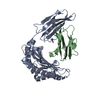 6j2fC 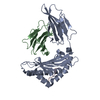 6j2gC  6j2hC 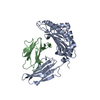 6j2iC  6k7tC  6k7uC C: citing same article ( |
|---|---|
| Similar structure data |
- Links
Links
- Assembly
Assembly
| Deposited unit | 
| ||||||||
|---|---|---|---|---|---|---|---|---|---|
| 1 | 
| ||||||||
| 2 | 
| ||||||||
| Unit cell |
|
- Components
Components
| #1: Protein | Mass: 32119.254 Da / Num. of mol.: 2 Source method: isolated from a genetically manipulated source Source: (gene. exp.)  Pteropus alecto (black flying fox) / Gene: Ptal-N / Production host: Pteropus alecto (black flying fox) / Gene: Ptal-N / Production host:  #2: Protein | Mass: 11748.160 Da / Num. of mol.: 2 Source method: isolated from a genetically manipulated source Source: (gene. exp.)  Homo sapiens (human) / Gene: B2M / Production host: Homo sapiens (human) / Gene: B2M / Production host:  #3: Protein/peptide | Mass: 997.080 Da / Num. of mol.: 2 / Source method: obtained synthetically Source: (synth.)  References: UniProt: K9N5Q8*PLUS #4: Water | ChemComp-HOH / | Has protein modification | Y | |
|---|
-Experimental details
-Experiment
| Experiment | Method:  X-RAY DIFFRACTION / Number of used crystals: 1 X-RAY DIFFRACTION / Number of used crystals: 1 |
|---|
- Sample preparation
Sample preparation
| Crystal | Density Matthews: 2.6 Å3/Da / Density % sol: 52.78 % |
|---|---|
| Crystal grow | Temperature: 291 K / Method: vapor diffusion, sitting drop Details: 0.2 M sodium acetate trihydrate, 20% w/v polyethylene glycol 3,350 |
-Data collection
| Diffraction | Mean temperature: 100 K / Serial crystal experiment: N |
|---|---|
| Diffraction source | Source:  SYNCHROTRON / Site: SYNCHROTRON / Site:  SSRF SSRF  / Beamline: BL19U1 / Wavelength: 0.97853 Å / Beamline: BL19U1 / Wavelength: 0.97853 Å |
| Detector | Type: SDMS / Detector: IMAGE PLATE / Date: May 19, 2018 |
| Radiation | Protocol: SINGLE WAVELENGTH / Monochromatic (M) / Laue (L): M / Scattering type: x-ray |
| Radiation wavelength | Wavelength: 0.97853 Å / Relative weight: 1 |
| Reflection | Resolution: 2.5→50 Å / Num. obs: 31557 / % possible obs: 97.2 % / Redundancy: 6.1 % / Net I/σ(I): 11.942 |
| Reflection shell | Resolution: 2.5→2.59 Å |
- Processing
Processing
| Software |
| |||||||||||||||||||||||||||||||||||||||||||||||||||||||||||||||||||||||||||||
|---|---|---|---|---|---|---|---|---|---|---|---|---|---|---|---|---|---|---|---|---|---|---|---|---|---|---|---|---|---|---|---|---|---|---|---|---|---|---|---|---|---|---|---|---|---|---|---|---|---|---|---|---|---|---|---|---|---|---|---|---|---|---|---|---|---|---|---|---|---|---|---|---|---|---|---|---|---|---|
| Refinement | Method to determine structure:  MOLECULAR REPLACEMENT / Resolution: 2.5→49.337 Å / SU ML: 0.32 / Cross valid method: NONE / σ(F): 1.35 / Phase error: 28.82 MOLECULAR REPLACEMENT / Resolution: 2.5→49.337 Å / SU ML: 0.32 / Cross valid method: NONE / σ(F): 1.35 / Phase error: 28.82
| |||||||||||||||||||||||||||||||||||||||||||||||||||||||||||||||||||||||||||||
| Solvent computation | Shrinkage radii: 0.9 Å / VDW probe radii: 1.11 Å | |||||||||||||||||||||||||||||||||||||||||||||||||||||||||||||||||||||||||||||
| Refinement step | Cycle: LAST / Resolution: 2.5→49.337 Å
| |||||||||||||||||||||||||||||||||||||||||||||||||||||||||||||||||||||||||||||
| Refine LS restraints |
| |||||||||||||||||||||||||||||||||||||||||||||||||||||||||||||||||||||||||||||
| LS refinement shell |
|
 Movie
Movie Controller
Controller





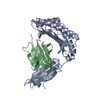

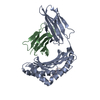
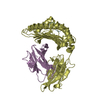
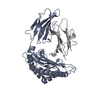

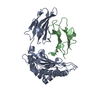



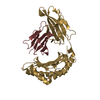
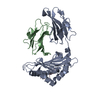


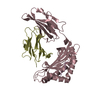

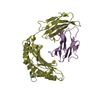
 PDBj
PDBj


